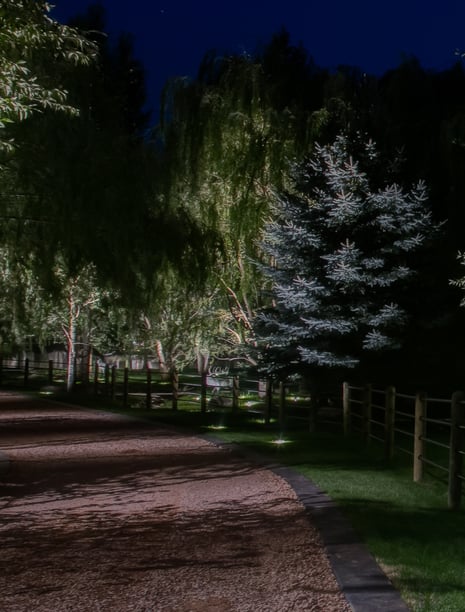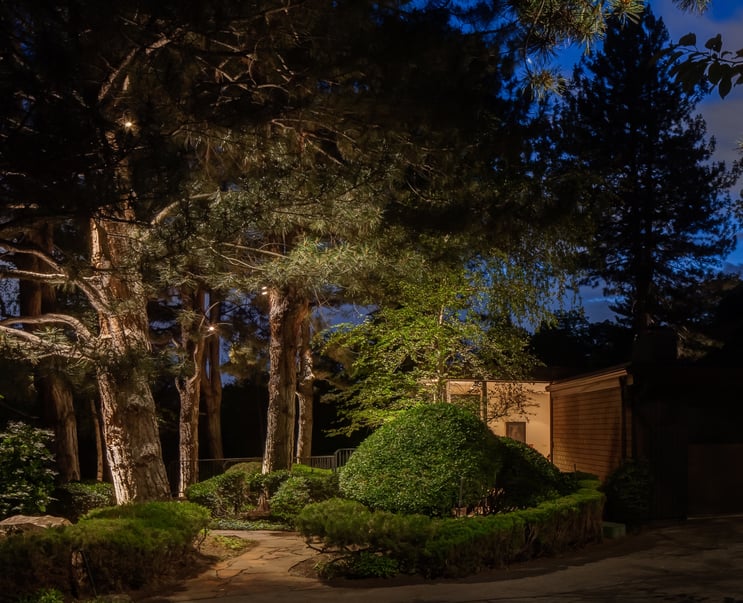Tree lighting ideas: Concepts for lighting trees in your landscape
There are four concepts to remember when lighting your evergreens with a low voltage outdoor lighting system:
- Light penetration
- Fixture placement
- View point
- Kelvin temperature choice.
Be it a Blue Spruce, an Eastern Hemlock, or even a Ponderosa Pine, these concepts can help you when you’re trying to figure out how to approach and light the evergreens around your home.
Let’s start with light penetration
Evergreens need to be lit differently than deciduous trees.
Deciduous trees can be uplit from below, as the light will penetrate the leaves and travel up to the canopy.
However, evergreens have thick, needle-covered branches that block light.
If an evergreen is uplit from below, the light will be blocked and defused before it has a chance to travel up through the tree. This will create a bright hot spot at the tree’s base.
Instead, evergreens should be lit from a distance with a 60-100° beam spread.
This will allow the light to penetrate the branches and illuminate the entire tree.
The larger the tree, the further back the directional up light will need to be to capture the tree.
There is an exception to this guideline.
When lighting a towering cedar, ponderosa pine, or other ancient evergreen, you may choose to light directly below using a narrow beam spread lamp.
These trees have low-hanging branches that are sometimes out of arm’s reach.
The branches of these trees are large and spread out enough that the light can still travel upwards when lit from below.

Fixture placement is important for a few reasons
The placement of light fixtures on evergreen trees depends on the size of the tree.
For towering evergreens, the fixtures can be placed directly below the tree. However, for young saplings, it is important to place the fixtures further away, as the tree will grow and its branches will spread.
If the fixtures are placed too close to the tree, they will eventually be engulfed by the branches.
To avoid this, it is important to service the lighting system every few years and move the fixtures back.
Another way to get around this issue is to use in-grade well lights in the lawn. These lights are placed directly in the ground and are less likely to be damaged by the tree’s branches.
When choosing in-grade well lights, it is important to make sure they are made of sturdy materials, such as solid brass or copper, and have a grate to protect them from lawnmowers and other hazards.
Where will the object be viewed when it’s illuminated?
No matter what kind of tree lighting you are doing, you need to consider your visual aspect.
Where will the object be viewed when it’s illuminated?
This is especially important with evergreens, as they can be wide and robust.
Knowing where the tree will be viewed will help you determine how much of the tree needs to be lit, and in turn, how many lights you need.

Kelvin temperature
Kelvin temperature is the hue or color temperature of the LED lamp.
With deciduous trees, we prefer to use a warmer 2700 Kelvin lamp.
When it comes to evergreens, however, we prefer to use a cooler 3000-3500 Kelvin lamp.
On a Blue Spruce, we will even use a 4000 Kelvin lamp.
Understanding Kelvin temperatures will be key to helping enhance the natural beauty of your evergreens.
Give us a call:
To learn more about how to light your outdoor living space, call us at (801) 440-7647 to schedule a free consultation, or feel free to simply fill out a contact form.
Salt Lake City (Midvale)
801-440-7647
St. George
435-932-6627
©2025 Landscape Lighting Pro
Privacy Policy
Cookie Policy